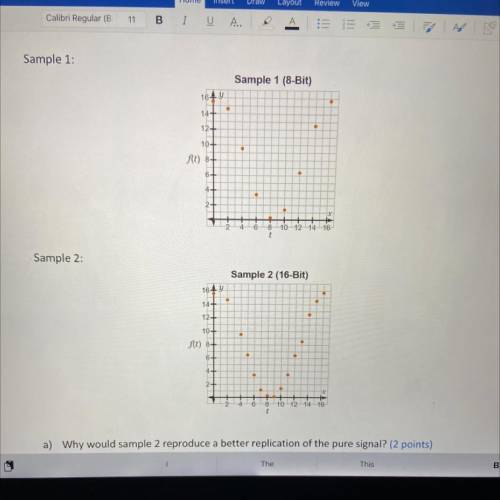
Mathematics, 26.10.2020 19:20 omoaye
in the real world humans hear sound as an analog signal. this means the signal is a continuous waveform which is completely processable by human ears. however machines 'hear' sound a little differently as they process sound digitally which is a discrete waveform. when sound is recorded or transmitted electronically the continuous (analog) waveform is sampled to convert it to a discrete (digital) sequence. sampling is the process of reducing a continuous time signal to a discrete-time signal. as the sampling rate increases the sound quality of the recording or transmission will improve. the graphs below represent two different samples of pure tone. sample one is taken 8 times per unit of time. sample two is taken 16 times per unit of time. a) why would sample 2 reproduce a better replication of the pure signal? b) write a sinusoid model for sample 2


Answers: 2


Another question on Mathematics

Mathematics, 21.06.2019 18:30
The bake stars picked 907 apples last weekend at a local orchard they made caramel apples and sold them in the bakery in trays of 6
Answers: 1

Mathematics, 21.06.2019 19:30
Which table shows a proportional relationship between miles traveled and gas used?
Answers: 2

Mathematics, 21.06.2019 20:30
Give the functions f(x) = |x + 2| - 3, what is the domain? a,b,c, or d all real numbers x > 2 x < -2 all real numbers and x cannot equal to 2
Answers: 1

Mathematics, 22.06.2019 00:00
I've been working on this for a few days and i just don't understand, it's due in a few hours. you.the direction of a vector is defined as the angle of the vector in relation to a horizontal line. as a standard, this angle is measured counterclockwise from the positive x-axis. the direction or angle of v in the diagram is α.part a: how can you use trigonometric ratios to calculate the direction α of a general vector v = < x, y> similar to the diagram? part bsuppose that vector v lies in quadrant ii, quadrant iii, or quadrant iv. how can you use trigonometric ratios to calculate the direction (i.e., angle) of the vector in each of these quadrants with respect to the positive x-axis? the angle between the vector and the positive x-axis will be greater than 90 degrees in each case.part cnow try a numerical problem. what is the direction of the vector w = < -1, 6 > ?
Answers: 1
You know the right answer?
in the real world humans hear sound as an analog signal. this means the signal is a continuous wavef...
Questions

History, 27.01.2020 09:31



Mathematics, 27.01.2020 09:31


Mathematics, 27.01.2020 09:31



Mathematics, 27.01.2020 09:31



History, 27.01.2020 09:31




Mathematics, 27.01.2020 09:31

Social Studies, 27.01.2020 09:31



Mathematics, 27.01.2020 09:31



